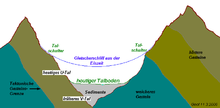Valley shoulder
In geomorphology, a valley shoulder is the edge of the terrain that runs parallel to the valley axis at a greater height above the valley floor ; below the Talschulter the narrow valley .
In the high mountains , valley shoulders are mainly found in trough valleys and are then called trough shoulders . They usually occur on both sides of the slope and at about the same height above the valley floor and were created by the glacial grinding during the ice and cold ages. Due to the erosive activity of the glacier, there are signs of deepening that can be more than 1000 m (Inntal, Salzachtal) and are filled with sediments postglacial . The competence of the rock plays a hardly relevant role for the erosive activity of the glacier (think of glacier cirques in metamorphic , highly competent rocks such as serpentinites ). In the course of post-glacial dynamics, mountain tears or valley thrusts can occur, as the valley flanks are no longer supported by the glacier mass. This leads to the development of characteristic shapes.
In particularly wide, glacial valleys, different heights of the glacier levels of the different ice ages and also cold ages can lead to the formation of several valley shoulders or terraces at different heights, e.g. B. in the South Tyrolean Langtauferer Tal near the Reschenpass in the Ötztal Alps . Often the river then forms a notch valley in the valley floor , e.g. B. in the Vorderrhein Valley .
The wider a mountain valley, the deeper the valley shoulder is usually. In the Inn Valley, for example, it is only 100–200 m above the valley floor and has the shape of a valley terrace on which - especially on the sunny side - there are numerous villages.
Valley shoulders have been populated in Switzerland since the Middle Ages where the river valley itself is narrow or exposed to frequent floods. Today, many such places have developed into holiday resorts, for example Braunwald , Flims , Obersaxen , Wengen , Mürren or Scuol .
The terraces are especially important in alpine areas and abundant groundwater reservoirs and form excellent aquifers (aquifer).
The terraces are often the starting point for spectacular waterfalls , for example in Lauterbrunnen valley or in Meiringen .
Valleys with a shoulder-like cross-section also occur in some canyons in North America, although the erosion there has nothing to do with glacial grinding, but depends on the erosive activity of the receiving water . See e.g. B. the geology of the Bryce Canyon (picture opposite).


